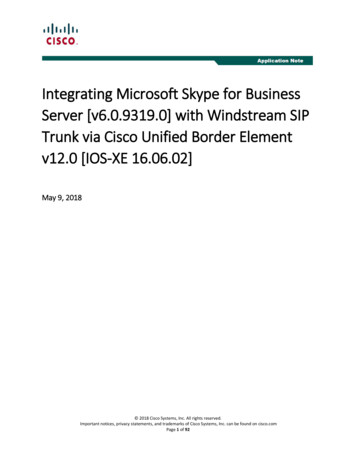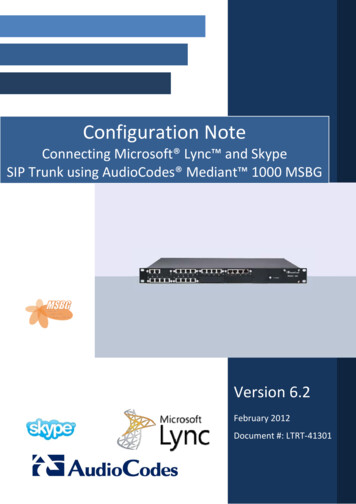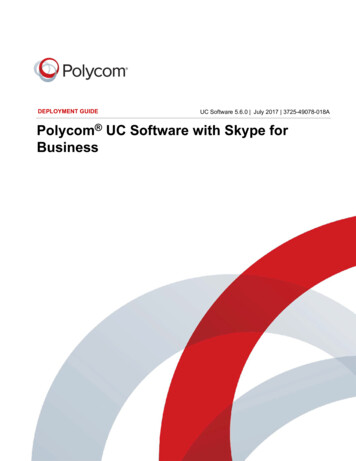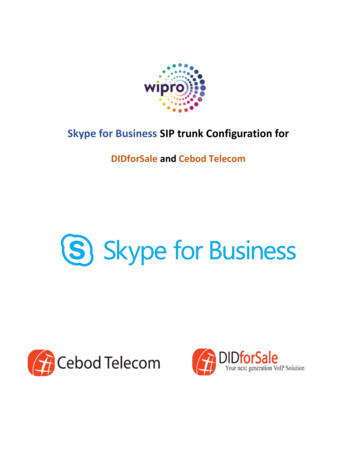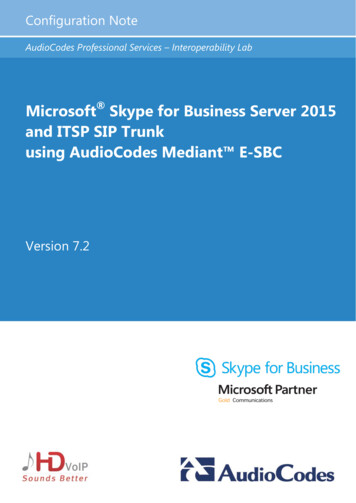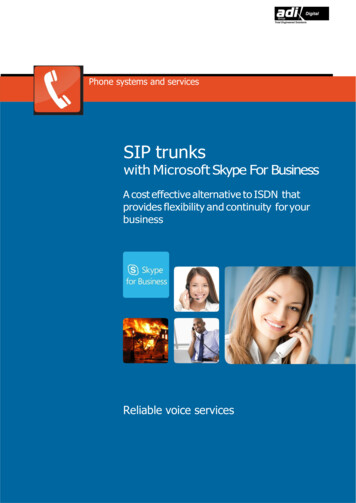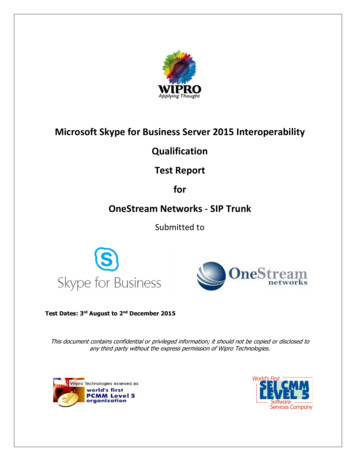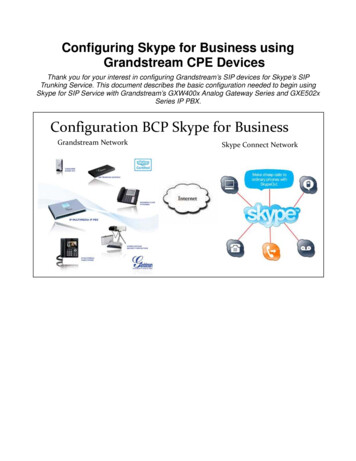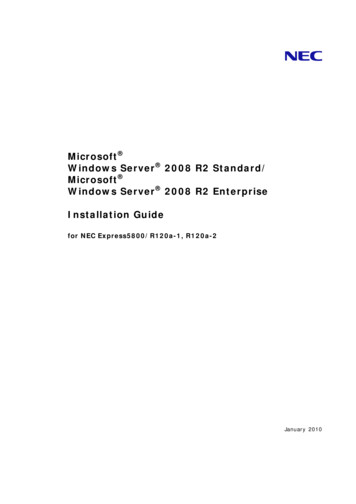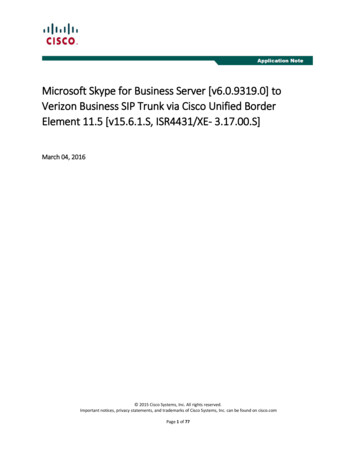
Transcription
Microsoft Skype for Business Server [v6.0.9319.0] toVerizon Business SIP Trunk via Cisco Unified BorderElement 11.5 [v15.6.1.S, ISR4431/XE- 3.17.00.S]March 04, 2016 2015 Cisco Systems, Inc. All rights reserved.Important notices, privacy statements, and trademarks of Cisco Systems, Inc. can be found on cisco.comPage 1 of 77
Table of ContentsIntroduction . 4Network Topology. 5System Components . 6Hardware Requirements . 6Software Requirements . 6Features . 6Features Supported . 6Features Not Supported. 6Caveats . 7Configuration . 8Configuring Cisco Unified Border Element . 8Network Interface . 8Global Cisco UBE settings. 11Codecs . 12SIP Profiles. 12Dial peer . 13Configuration example. 18Configuring Microsoft Skype for Business Server . 50PSTN gateway configuration . 50Voice Routing Configuration . 62User Configuration . 74Acronyms . 76Important Information . 76 2015 Cisco Systems, Inc. All rights reserved.Important notices, privacy statements, and trademarks of Cisco Systems, Inc. can be found on cisco.comPage 2 of 77
Table of FiguresFigure 1 Network Topology . 5Figure 2 High Availability topology . 8Figure 3 Add new IP/PSTN Gateway in Skype for Business Topology Builder . 50Figure 4 Define the FQDN of the CUBE . 51Figure 5: IPv4/IPv6 address selection . 52Figure 6: Transport protocol and Port number. 53Figure 7 PSTN Gateway is added successfully using TCP . 54Figure 8 Trunk to CUBE is added successfully in TCP . 54Figure 9 Add new IP/PSTN Gateway in Skype for Business Topology Builder . 55Figure 10 FQDN of the CUBE . 56Figure 11: IPv4/IPv6 address selection . 57Figure 12: Transport protocol and Port number . 58Figure 13 PSTN Gateway to CUBE is added successfully using TLS . 59Figure 14 Trunk to CUBE is added successfully using TLS . 59Figure 15 Publish the Skype for Business topology . 60Figure 16 Changes to the Topology published successfully . 61Figure 17 Voice Routing Configuration . 62Figure 18 New User Voice Policy configuration . 63Figure 19 New PSTN Usage Record configuration . 64Figure 20 New Voice Route details and Add Trunk to associate . 65Figure 21 Select Trunk to associate with Route . 66Figure 22 Commit changes to Voice Policy . 66Figure 23 Voice Policy added successfully . 67Figure 24 New Pool Trunk . 68Figure 25 Select the Trunk Service . 69Figure 26 New Trunk Configuration . 70Figure 27 Associate PSTN Usage to the Trunk . 71Figure 28 Commit the Changes to the Trunk . 72Figure 29 Trunk to CUBE added successfully . 73Figure 30 Skype User Configuration 1. 74Figure 31 Skype User Configuration 2. 75 2015 Cisco Systems, Inc. All rights reserved.Important notices, privacy statements, and trademarks of Cisco Systems, Inc. can be found on cisco.comPage 3 of 77
IntroductionService Providers today, such as Verizon, are offering alternative methods to connect to the PSTN viatheir IP network. Most of these services utilize SIP as the primary signaling method and centralized IP toTDM POP gateways to provide on-net and off-net services.Verizon Business SIP Trunk is a service provider offering that allows connection to the PSTN and mayoffer the end customer a viable alternative to traditional PSTN connectivity. A demarcation devicebetween these services and customer owned services is recommended. As an intermediary devicebetween Microsoft Skype for Business Server 2015 and Verizon network, Cisco Unified Border Element(Cisco UBE 11.5.0) 15.6.1.S [IOS-XE 3.17] can be used. The Cisco Unified Border Element (Cisco UBE)15.6.1.S provides demarcation, security and inter-working and session control services for MicrosoftSkype for Business Server 2015 connected to Verizon IP network.This document assumes the reader is knowledgeable with the terminology and configuration ofMicrosoft Skype for Business Server 2015. Only configuration settings specifically required for Verizoninteroperability are presented. Feature configuration and most importantly the dial plan are customerspecific and need individual approach. This application note describes how to configure a Microsoft Skype for Business Server 2015 andCisco Unified Border Element (Cisco UBE 11.5.0) 15.6.1.S [IOS-XE 3.17] for connectivity to VerizonSIP Trunking service. The deployment model covered in this application note is Skype for BusinessServer 2015 to PSTN via Cisco Unified Border Element (Cisco UBE) 15.6.1.S. Testing was performed in accordance to Cisco generic SIP Trunking test methodology and amongfeatures verified were – basic calls, DTMF transport, Music on Hold (MOH), unattended andattended transfers, call forward, conferences and High Availability. The Cisco Unified Border Element (Cisco UBE) configuration detailed in this document is based ona lab environment with a simple dial-plan used to ensure proper interoperability between VerizonSIP network and Microsoft Skype for Business Server. The configuration described in thisdocument details the important configuration settings to have enabled for interoperability to besuccessful and care must be taken by the network administrator deploying Microsoft Skype forBusiness Server to interoperate to Verizon SIP Trunking network. 2015 Cisco Systems, Inc. All rights reserved.Important notices, privacy statements, and trademarks of Cisco Systems, Inc. can be found on cisco.comPage 4 of 77
Network TopologyFigure 1 Network Topology The network topology includes the Microsoft Skype for Business Server Enterprise Edition and 2Lync clients. Cisco UBE published as a PSTN gateway in the Skype for Business Server topology.Verizon was used as the service provider with a SIP trunk to the Cisco UBE2 Cisco Unified Border Elements are used here for High Availability.SIP Trunk transport type used between Cisco Unified Border Element and Microsoft Skype forBusiness is either TCP or TLS. Configuration for each trunk type is explained in the Dial-peersection of this document.IP-PBX - CUBE Trunk Settings:SettingValueMedia BypassOFFREFER SupportONSession TimerONEarly Media support with PRACKON 2015 Cisco Systems, Inc. All rights reserved.Important notices, privacy statements, and trademarks of Cisco Systems, Inc. can be found on cisco.comPage 5 of 77
System ComponentsHardware Requirements Cisco UBE on Cisco ISR 4431 routerGeneric Server for Skype for BusinessSoftware Requirements Cisco UBE IOS CUBE-Version: 11.5.0, SW-Version: 15.6.1.S, XE- 3.17.00.SMicrosoft Skype for Business Server 2015- Version: 6.0.9319.0Microsoft Skype for Business Client – Version 15.0.4797.1000FeaturesFeatures Supported Incoming and outgoing off-net calls using G711International Calls and digit manipulationsCall ConferenceCPE Voice Mail supportCall hold & Resume with and without MoHUnattended and Attended Call transferCall forward (all and no answer)DTMF (RFC2833)IP-PBX Calling number privacyHigh AvailabilityEarly Media supportFeatures Not Supported G729 is not Supported by Skype for BusinessFax (G.711 and T.38)Blind Call transferCall forward on Busy 2015 Cisco Systems, Inc. All rights reserved.Important notices, privacy statements, and trademarks of Cisco Systems, Inc. can be found on cisco.comPage 6 of 77
Caveats Skype for Business does not support G729 so g711 is preferred. Trunk from Skype for Business to CUBE is tested with both TCP / RTP and TLS / SRTP. Ring back tone is not heard in off-net phone when the Skype user transfers the call. Caller ID updates are not observed on attended call transfer scenarios. Testing is done with only one IP PBX. Skype for Business requires 3rd party FAX for FAX support The Media Bypass is turned off in trunk between Skype for business and CUBE Workaround is done for SRTP negotiation between Skype for Business and CUBE Workaround is done for Diversion header manipulations for Call Forward and call Transfer RTCP Sender reports are not sent from CUBE to Skype unless ITSP sends it to CUBE. CUBE has an added dial-peer for Skype for Business REFER support to work SIP Global Binding should be done with the interface pointing to Skype for Business 2015 Cisco Systems, Inc. All rights reserved.Important notices, privacy statements, and trademarks of Cisco Systems, Inc. can be found on cisco.comPage 7 of 77
ConfigurationConfiguring Cisco Unified Border ElementNetwork InterfaceThe IP address used are for illustration only, the actual IP address can vary. The Active/Standby pairshare the same virtual IP address and continually exchange status messages.Figure 2 High Availability topology 2015 Cisco Systems, Inc. All rights reserved.Important notices, privacy statements, and trademarks of Cisco Systems, Inc. can be found on cisco.comPage 8 of 77
CUBE 1:interface GigabitEthernet0/0/0ip address 10.64.4.19 255.255.0.0media-type rj45negotiation auto!interface GigabitEthernet0/0/1no ip addressshutdownmedia-type rj45negotiation auto!interface GigabitEthernet0/0/2description LAN interfaceip address 10.80.22.74 255.255.255.0media-type rj45negotiation autoredundancy rii 1redundancy group 1 ip 10.80.22.100 exclusive!interface GigabitEthernet0/0/3description WAN interfaceip address 192.65.79.114 255.255.255.224media-type rj45negotiation autoredundancy rii 2redundancy group 1 ip 192.65.79.124 exclusive! 2015 Cisco Systems, Inc. All rights reserved.Important notices, privacy statements, and trademarks of Cisco Systems, Inc. can be found on cisco.comPage 9 of 77
CUBE 2:!interface GigabitEthernet0/0/0ip address 10.64.4.20 255.255.0.0media-type rj45negotiation auto!interface GigabitEthernet0/0/1no ip addressshutdownmedia-type rj45negotiation auto!interface GigabitEthernet0/0/2ip address 10.80.22.75 255.255.255.0media-type rj45negotiation autoredundancy rii 1redundancy group 1 ip 10.80.22.100 exclusive!interface GigabitEthernet0/0/3description Wan Interfaceip address 192.65.79.115 255.255.255.224media-type rj45negotiation autoredundancy rii 2redundancy group 1 ip 192.65.79.122 exclusive! 2015 Cisco Systems, Inc. All rights reserved.Important notices, privacy statements, and trademarks of Cisco Systems, Inc. can be found on cisco.comPage 10 of 77
Global Cisco UBE settingsIn order to enable Cisco UBE IP2IP SBC functionality, following command has to be entered:voice service voipno ip address trusted authenticatertcp keepaliveaddress-hidingmode border-element license capacity 20allow-connections sip to sipredundancy-group 1no supplementary-service sip moved-temporarilyno supplementary-service sip refersupplementary-service media-renegotiatesipbind control source-interface GigabitEthernet0/0/2bind media source-interface GigabitEthernet0/0/2session profiles inboundsip-profiles 248 ons sip to sipAllow IP2IP connections between two SIP call legsredundancy-group 1Enable High Availability for the VoIP servicertcp keepaliveEnables the CUBE to send rtcp keepalive packets for the session keepaliveBind control and mediaSIP Global binding is done with the interface pointing to Skype for Business toavoid TCP socket issue 2015 Cisco Systems, Inc. All rights reserved.Important notices, privacy statements, and trademarks of Cisco Systems, Inc. can be found on cisco.comPage 11 of 77
CodecsG711 is used as the preferred codec for this testing as G729 is not supported in Skype for Business.voice class codec 2codec preference 1 g711ulawcodec preference 2 g729r8 bytes 30codec preference 3 g726r32codec preference 4 g729br8SIP ProfilesSIP Profile 1 is used in the dial-peer pointing towards Verizon. Here the Diversion header is inserted bycopying the uri from “REFERRED-BY” header and then truncating the preceding “ 1”. SIP Profile 248 isused to invalidate the ‘a’ attribute of the SDP that has MKI. As the CUBE does not support crypto withMKI we have to apply this profile for the SRTP calls to work.voice class sip-profiles 1request INVITE peer-header sip REFERRED-BY copy "sip:(.*)@" u01request INVITE sip-header Diversion add "Diversion: sip:sipuri@192.65.79.122 "request INVITE sip-header Diversion modify "sip:(.*)@" "sip:\u01@"request INVITE sip-header Diversion modify "sip:\ 1" "sip:"request REFER sip-header Referred-By removevoice class sip-profiles 248request ANY sdp-header Audio-Attribute modify"a (.*)AES CM 128 HMAC SHA1 (.*) inline(.*)\ (.*):(.*)" "a \1CRYPTO UNKNOWNinline\3 \4:\5"response ANY sdp-header Audio-Attribute modify"a (.*)AES CM 128 HMAC SHA1 (.*) inline(.*)\ (.*):(.*)" "a \1CRYPTO UNKNOWNinline\3 \4:\5" 2015 Cisco Systems, Inc. All rights reserved.Important notices, privacy statements, and trademarks of Cisco Systems, Inc. can be found on cisco.comPage 12 of 77
Dial peerDial-peer to Skype for Business for TCP with RTP:!dial-peer voice 107 voipdescription " Incoming PSTN to IP-PBX - IP-PBX facing side "translation-profile outgoing e164destination-pattern 719.session protocol sipv2session target dns:lync1.sfblabis.local:5060session transport tcpincoming uri request FQDNsfbvoice-class codec 2voice-class sip localhost dns:isr4k.sfblabis.local:5060voice-class sip call-route urlvoice-class sip options-keepalivevoice-class sip bind control source-interface GigabitEthernet0/0/2voice-class sip bind media source-interface GigabitEthernet0/0/2dtmf-relay rtp-nterefer consumeno vad!dial-peer voice 105 voipdescription incoming from IP-PBXsession protocol sipv2session transport tcpincoming called-number 921424259.voice-class codec 2voice-class sip localhost dns:isr4k.sfblabis.local:5060voice-class sip copy-list 1voice-class sip bind control source-interface GigabitEthernet0/0/2 2015 Cisco Systems, Inc. All rights reserved.Important notices, privacy statements, and trademarks of Cisco Systems, Inc. can be found on cisco.comPage 13 of 77
voice-class sip bind media source-interface GigabitEthernet0/0/2dtmf-relay rtp-nteno vad!dial-peer voice 786 voipdescription TEST for REFERtranslation-profile outgoing e164session protocol sipv2session target sip-urisession transport tcpdestination uri SFBvoice-class codec 2voice-class sip localhost dns:isr4k.skypelabsk.local:5060voice-class sip profiles 248voice-class sip bind control source-interface GigabitEthernet0/0/2voice-class sip bind media source-interface GigabitEthernet0/0/2voice-class sip referto-passingvoi
SIP network and Microsoft Skype for Business Server. The configuration described in this document details the important configuration settings to have enabled for interoperability to be successful and care must be taken by the network administrator deploying Microsoft Skype for Business Server to inter

